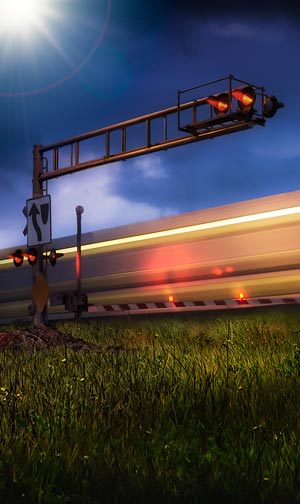Driver Injured and Ticketed when Struck by CSX Train at Non-Gated Quiet Zone Crossing
(Hagerstown, Maryland – May 3, 2013)
Stopping and then following two other motorists through the non-gated grade crossing of CSX railroad tracks and Potomac Avenue in Hagerstown, MD in her Dodge Neon, a Chambersburg, PA motorist was struck by a pair of CSX locomotives hauling no rail cars, injured and then ticketed for “failure to stop at a railroad crossing” Friday morning at about 9:06 A.M.
Shonda M. Dosher was taken to Meritus Medical Center East in Hagerstown for treatment of minor injuries, according to Hagerstown Fire Chief Mark Cleck, while Hagerstown Police Chief Mark Holtzman said she was cited for her allegedly errant actions, but had no record of any police action regarding the two vehicles which led her into harm’s way.
Not only is there an absence of gates at the CSX/Potomac Avenue intersection, but the crossing, according to a CSX official at the scene, is in a Federal Railroad Administration permitted “Quiet Zone”, a corridor which bans the normal use of locomotive horns, but allows their activation in case of emergency. However, the official, who refused to provide his name, added that “Trains passing through that intersection are not allowed to blow their horns because it is a residential area.”
A check of FRA records on the crossing revealed the crossing to, indeed, be in a “Quiet Zone”, that there have now been four accidents at the crossing with a total injury count of three, and that the maximum allowable train speed over the crossing is 10 mph.
Interestingly, however, was advice from the FRA’s “Updated Analysis of Train Whistle Bans”, published in January, 2000, which stated “At crossings equipped with flashing signal lights and/or other active warning devices, but not gates, collisions occurred 119 percent more often at crossings subject to bans.”
The FRA report further points out that “in the case of crossings with flashing light signals and/or other active devices, collisions may be more the result of a motorist’s error in judgment rather than a deliberate violation of the state’s motor vehicle laws. The ambiguity of flashing red lights at crossings, which in other traffic control situations indicate that the motorist may proceed after stopping, when safe to do so, coupled with the difficulty of correctly judging the rate of approach of a large object, such as a locomotive, likely contribute to the phenomenon. FRA’s collision data show that the added warning provided by the train horn is most critical at crossings without gates but which are equipped with other types of active warning devices.”


